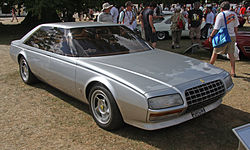Ferrari Pinin
| Ferrari | |
|---|---|

Ferrari Pinin |
|
| Pinin | |
| Presentation year: | 1980 |
| Vehicle fair: | Turin Motor Show 1980 |
| Class : | Upper class |
| Body shape : | limousine |
| Engine: |
Otto engine : 5.0 liters |
| Production model: | none |
The Ferrari Pinin is a prototype developed by Pininfarina for a four-door sedan for the Italian car manufacturer Ferrari . The Pinin was built as a single piece in 1980 . The initiative for this project went back to Sergio Pininfarina , who had long dreamed of designing an Italian competitor for luxury sedans such as the Jaguar XJ , the Maserati Quattroporte (designed by Giugiaro) or the Mercedes 450 SEL 6.9 .
The design
The design of the Pinin was created by Pininfarina's designer Leonardo Fioravanti ; Diego Ottina did the detailed work. Fioravanti was already involved in the design of the Fiat 130 Coupé and the Ferrari 365 GT4 2 + 2 . His Ferrari sedan followed the tradition of these designs. It showed a smooth line with a tall passenger cell. The side windows were led over the vehicle pillars. This gave the impression of generous glazing. A double accent line ran a short distance from the belt from the front of the car to the rear. The recessed door handles and the door locks were integrated into the bead. Pininfarina later took up this style element in his designs for the Alfa Romeo 164 and the Peugeot 605 in an intensified form. The headlights were behind a glass cover; beneath it were wide indicators and also glazed fog lights. The large Ferrari-style grille broke through the front bumper and reached down to the front spoiler. Opel adopted this front design for the second series of the Senator . The taillights, which were manufactured by Carello , were largely glazed in white. Individual parts only glowed in color when activated. This element was found half a decade later in the Cadillac Allanté , also designed by Pininfarina .
The Pinin followed the classic drive concept with a front engine and rear-wheel drive. The drive unit was the 5 liter V12 flat engine from the 512 BB , the low height of which enabled a low front section. Following the transaxle design , the gearbox should be on the rear axle.
The interior was extensively equipped with leather. Instead of a dashboard, the pinin carried a flat screen on which the essential information was displayed digitally. The system was to be developed by Ferrari in collaboration with Borletti. Fioravanti took up the concept of the Aston Martin Lagonda here . To the left and right of the screen there were operating satellites with pressure switches.
The prototype
Pininfarina made a non-roadworthy prototype of the Pinin. The silver painted car had a light brown leather interior and used a manual five-speed gearbox from Ferrari.
The car was presented to the public at the Turin Motor Show in 1980 and caused quite a stir. Following the exhibition, the car was taken to the USA , where it was exhibited on various occasions in order to further investigate customer interests.
In 2008 a private buyer bought the prototype of the Pinin. He hired the former Ferrari engineer Mauro Forghieri to get the car ready to drive. Forghieri's design office Oral Engineering designed the drive train, the electrics and accessories such as the tank. The twelve-cylinder flat engine that Pininfarina had initially planned was used as the drive. In March 2011, the Pinin moved on its own for the first time.
Decision against series production
In early 1981, Enzo Ferrari decided against series production of the Pinin. According to Leonardo Fioravanti, the main reason for this was doubts about producing such a car with the required quality: “When Ferrari produced a two-door hatchback, then sportiness was the essential criterion, and one could forgive one or the other lack of quality. But the quality level for four-door cars is different from that for two-door cars. With the Pinin we would compete against BMW, Mercedes and Rolls-Royce! ”Quality deficiencies could quickly have destroyed the reputation of the Pinin. Ultimately, Ferrari did not want to take this risk. The pinin remained a one-off.
literature
- Ferrari's Four-Door Fantasy. In: Thoroughbred & Classic Cars. Vol. 36, September 2008, ISSN 0143-7267 , p. 48 ff. (Presentation of the Pinin with numerous illustrations).
- Hans-Karl Lange: Battista Farina. In the name of the father ... - Ferrari's first four-door is actually driving now. In: Autobild Klassik. Issue 8, 2011, ISSN 2190-0744 , p. 68 ff.

